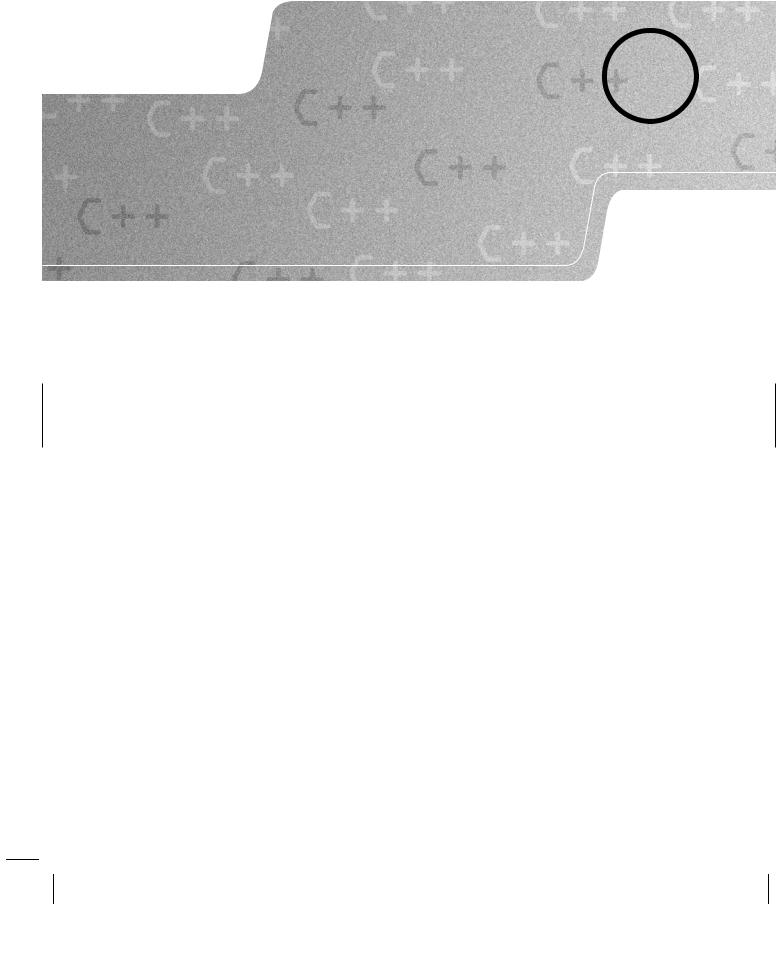
You Can Program In C++ (2006) [eng]
.pdf
218 |
CHAPTER 11 |
REFERENCE SECTION
Pointers
These are derivative types whose values are the addresses of instances of a type. We obtain the name of a pointer type by appending an * (asterisk) to the name of the type whose instances we wish to address. So int* is the pointer type for storing addresses of ints, and card* is the pointer type for holding addresses of card objects.
If we want to use the object addressed by a pointer, we obtain it by prefixing the pointer with an asterisk. Therefore, if i ptr is an int* containing the address of an int, *i ptr will be an alias for the int. If mt ptr is a mytype* holding the address of an instance of mytype, mt ptr->member is equivalent to (*mt ptr).member. However, we can overload both operator* and operator-> for user-defined types, so that equivalence could be broken if the programmer providing the overloads does so inconsistently.
Like all other non-reference data types, you can append const to a pointer type to mark the variable being declared as immutable. So
int i(0);
int* const ic_ptr(&i);
makes ic ptr an immutable pointer to i. In other words, we cannot assign the address of another int to ic ptr.
We can also const-qualify the type being pointed to. That prevents the program from using the address stored in the pointer to change the addressed object. For example,
int i(0);
int const * ci_ptr(&i);
restricts uses of *ci ptr (dereferencing ci ptr to get the object whose address is stored in it) to reading the value of the object addressed. Even though i is mutable (and so we could write i = 0;), we cannot write *ci ptr = 1;.
The following is equivalent to the above definition of ci ptr:
const int * ci_ptr(&i);
However, for consistency, I prefer to place the const qualifier directly to the right of the type being qualified.
A pointer to an element of an array (strictly speaking, C++ mostly treats single objects as arrays of one element) can be incremented (++) or decremented (--) to locate an immediately succeeding or preceding element of the same type. You may also add or subtract an integer value to move forward or backward that number of elements. It is the responsibility of the programmer to ensure that such an element exists and is part of the same array. Stepping off either end of an array results in undefined behavior. There is one exception to this rule: C++ allows a pointer to hold the address of just beyond an array or object, but any attempt to dereference such a pointer results in undefined behavior.
There is a second special case: assigning (or initializing) 0 (often provided as a manifest constant called NULL) to a pointer results in placing the pointer in a safe state (but one that must not be dereferenced). We call a pointer that results from this a null pointer. A null pointer has the bool value false; all other pointers are treated as true.
C++ provides a special pointer type, void*, which can store the address of any instance of a data type. However, the only thing we can do with such a pointer is convert it back to a correctly typed pointer for the address stored.
C++ also supports pointers to functions.

POINTERS, SMART POINTERS, ITERATORS, AND DYNAMIC INSTANCES |
219 |
Arrays
C++ has a primitive (one-dimensional) array mechanism inherited from C. Arrays are always based on zero; in other words, the first element of an array x is x[0]. There are three variants for declaring an array:
•type array-name[number-of-elements];
Given that number-of-elements is a compile-time constant, this declares an array array-name of number-of- elements instances of type.
•type array-name[number-of-elements] = {initializer-list};
The array array-name is said to be directly initialized. If there are fewer initializers than number-of-elements, the remaining elements are default-initialized (to zero for fundamental types and pointers).
•type array-name[ ] = {initializer-list};
The number of elements in the array array-name is implicitly determined from the number of initializers that have been provided.
Using the name of an array in a context where we need a pointer results in the first element of the array being addressed.
We cannot pass or return arrays by value; instead, we use the address of the array (often implicitly).
If we need multi-dimensional arrays we have to create arrays of arrays (of arrays . . .). For example, a ten-by-eight array of int is declared as:
int twoD[10][8];
An initialized two-dimensional array of double might be declared as
double array2d[3][5] = {{0, 1, 2, 3, 4}, {2,4,7}};
which would create an array of the following form:
0.0 1.0 2.0 3.0 4.0
2.0 4.0 7.0 0.0 0.0
0.0 0.0 0.0 0.0 0.0
Note that once you start initializing, any elements without explicit initializers are set to 0. Only the first dimension can have an implicit size. Therefore:
int array[ ][3] = {{2, 3, 4}, {3}};
defines an array of two arrays of three ints. However,
int array[4][ ] = {{2, 3, 4}, {3}};
is an error.
Smart Pointers
The term ‘smart pointer’ refers to a user-defined type that, at a minimum, provides overloads for operator-> (the arrow operator, which is applied to a pointer or smart pointer to access a member of the instance whose location is provided by the (smart) pointer) and operator* (which converts a (smart) pointer into the object it locates, the operation called dereferencing).

220 |
CHAPTER 11 |
Smart pointers allow us to add extra behavior to the pointer concept. We often use a smartpointer type to manage the lifetime of a dynamic object. Such management is important in contexts where exceptions may have to be dealt with; we need to deal with the release of resources.
std::auto ptr<> is the only smart pointer provided by the Standard Library. It is of limited usefulness because of its quirky copy semantics. Other smart-pointer types are available from Boost (http://www.boost.org/), which is the official site for a group of highly skilled library developers testing items that might be added to the next full release of C++ (circa 2009), and some of them are in the recently published Library Technical Report.
Iterators
A C++ iterator does not match the computer-science concept of an iterator. In C++, an iterator is any type (or value of such a type) that locates an object (i.e. it is a raw pointer or smart pointer). The various Standard Library collection types such as std::vector<>, std::map<>, etc. provide nested iterator types to support access to the contained elements.
Generic Programming and the STL [Austern 1999] gives a detailed description of the design and implementation of iterators.

C H A P T E R 12
User-Defined Types, Part 4: Class hierarchies, polymorphism, inheritance, and subtypes
C++ provides a mechanism for deriving a new user-defined class type from an existing one. In the early days of C++, this mechanism was widely used by programmers who wanted to add to or modify the functionality of an existing class. These days, that is less common, because programmers have become more sophisticated in the use of their tools.
C++ provides three ways to use an existing class as the base for a new one: public, protected, and private inheritance. In this book, I will focus on public inheritance, because the correct use of the other two forms is highly specialized. I am also going to stick strictly to the use of inheritance for providing a class hierarchy where different subclasses may have different implementations of the same interface.
The concept of a planar shape is a common example. Every shape should have a function that displays (draws) it on the screen. However, the way we draw a circle is quite different from the way we draw a regular pentagon. If we had a collection of shapes created at run time according to a user’s choices, one piece of functionality for the program would be to refresh the display on the monitor. We would want to iterate through the collection, asking each shape to display itself.
This process of providing different implementations for different cases is an example of something that computer science calls polymorphism (literally, ‘many behaviors’). C++ supports several types of polymorphism – both overloading and templates are, in some uses, examples of static (compile-time) polymorphism. We are going to use inheritance to provide runtime, or dynamic, polymorphism. In other words, the compiler delays the decision as to which detailed behavior is appropriate until execution time.
For the purposes of introducing you to the concept and implementation of polymorphism, I am going to develop some code to deal with chess pieces. Every chess piece can move, but the details of the move depend on which piece it is. I will deal with the advanced issue where we need an object (chess piece) to be able to change its behavior (the promotion of a pawn to another piece) in a later chapter. In computer-science terminology, a specific chess piece (such as a knight or a bishop) is a subtype of the concept of a chess piece.
We use the term ‘subtyping’ to refer to cases where objects of a derived type are strictly usable wherever we require an object of the base type. An object of a subtype may have extra behavior, but it has all the behavior of the base type even if the implementation details may be different. We often call this relationship between base and derived type the Liskov Substitution Principle (after Barbara Liskov, who first stated it).
Some readers may not be familiar with the basic moves of chess pieces. I did a quick search of the Internet when I started to write this chapter, using the keywords ‘chess’, ‘tutorial’, and ‘beginners’. I got over a quarter of a million hits. Fortunately, several early hits met my need. At the time of writing, http://www.intuitor.com/chess/ provides exactly what we need. It might not still be there when you look, which is why I am telling you how I found it.

222 |
CHAPTER 12 |
An Interface for a Chess Piece
Our first step is to decide what the common properties and types of behavior for a chess piece are. Every chess piece has a color (black or white) and a location (its position on the chessboard – or off the chessboard because it has been captured). Every chess piece has the ability to move, but exactly what moves are legal depends on which piece it is, and in the case of rooks (castles) and kings we have to track past behavior (to allow for the combined move of ‘castling’). That last piece of behavior is difficult, because it is not a property of an individual piece.
Here is a possible design for a class to represent a general chess piece:
class basic_chesspiece{ public:
struct position{
unsigned char file; // location across the board unsigned char rank; // location towards the opponent
};
static position const off_board; virtual bool move(position const &); position where( )const;
bool is_white( )const;
explicit basic_chesspiece(bool white = true, bool castle = false); explicit basic_chesspiece(position const &, bool white = true,
bool castle = false); virtual ~basic_chesspiece( );
private:
bool const white_; // a chess piece is white or not-white position location_;
bool can_castle_; // disable copying
basic_chesspiece(basic_chesspiece const &); basic_chesspiece & operator=(basic_chesspiece const &);
};
W A L K T H R O U G H
There are several new things in the above definition. The first, though not entirely new (I have mentioned it before), is the nested struct definition. Let me answer the simple question first: why did I define it as a struct rather than as a class? You already know that the two keywords are, apart from one small detail, synonymous. The small detail is that a struct has public access by default. I want to emphasize that the position type that is a member of basic chesspiece gives public access to its data. Whether or not that is a good design is a different issue, one that we could debate over a beer sometime.
The second question is: why do I have a nested type at all? The location of a chess piece on a chessboard is made up of the rank (or row) and file (or column) of the square that it is on. Those two values are intimately related and I want to encapsulate that relationship into a type. I do not want to provide any special behavior for this type – well, not at the moment, though I might change my mind

CLASS HIERARCHIES, POLYMORPHISM, INHERITANCE, AND SUBTYPES |
223 |
later on. C++ (like C and many other languages, but unlike Python, for example) restricts returns from functions to a single value or object. The position type allows me to package the two values locating a chess piece into a single object or value.
The next thing you will notice is the appearance of a new keyword, virtual. The effect of this keyword is to warn the compiler that we are declaring a member function that may have more than one implementation. Yes, read that again. This is not overloading but something else: a single declaration with context-dependent implementations. Please do not panic – you will shortly see how this can work, and how the context for the decision can be delayed until execution time. The technical term for such delayed selection of implementation code is ‘dynamic binding.’
Now have a quick look at the end of the definition before we look at the rest of the public interface. The last two declarations are the idiomatic way that C++ programmers use to switch off the copy semantics that class types have by default. Because we have declared them, the compiler is relieved of the responsibility for them. Because they are private, nothing outside the class can call them; any attempt to do so will result in the compiler diagnosing an access violation. Moreover, when we come to write the implementation, we will not define those two functions; that way, an accidental attempt to use one while implementing the class will cause a link-time error (‘undefined function’ or something equivalent).
Back to the public interface. The member functions move( ) and where( ) are to allow us to instruct a chess piece to move somewhere else, and to ask a chess piece where it is currently (either on a particular square or off the board). The implementation of move( ) will depend on which chess piece we are using, so we declare it as virtual. In other words, we do not know what constitutes a legitimate move until we know which piece we are moving. We cannot know that at compile time (statically) and so must delay the choice of implementation until run time (dynamic binding).
It is probably not clear why I have declared the destructor as virtual. For the time being, take it as a coding guideline that any class with a virtual member function and a public destructor (yes, there are special class designs which incorporate non-public destructors) must declare a virtual public destructor.
All we have left of the public interface are the two constructors and a static data member. I have declared both constructors as explicit because we could use either of them with a single argument, and I do not want that possibility to allow the compiler to use a constructor as an implicit conversion operator (in the first case from bool to basic chesspiece, and in the second case from basic chesspiece::position to basic chesspiece).
The static data member off board avoids having some sort of magic value for the position of a chess piece that is off the board. How we represent the ‘off board’ location is unimportant (to the user), but it will help in reading code if we provide a name for that special value for position. In addition, it is a value that users of the class may need to refer to.
Testing the Interface
As soon as we have defined a tentative design for a class, we should create a test program that, at a minimum, uses each of the public members of the class. Here is an example of one for basic chesspiece:
#include "chess.h" #include <iostream> #include <ostream>
int main( ){ try{

224 |
CHAPTER 12 |
|
|
basic_chesspiece bc; |
|
|
basic_chesspiece::position pos; |
|
|
pos = bc.where( ); |
|
|
std::cout |
<< "The piece is on rank " << pos.rank |
|
<< ", |
file " << pos.file << ".\n"; |
|
bc.move(pos); |
|
|
std::cout |
<< "The piece is "; |
|
if(bc.is_white( )) std::cout << "white"; |
|
|
else std::cout << "black"; |
|
|
std::cout |
<< ".\n"; |
|
} |
|
|
catch(...){ |
|
|
std::cerr |
<< "Caught an exception.\n"; |
|
} |
|
|
} |
|
T R Y T H I S
Create a new project. Create three files in that project called test chess.cpp, chess.h and chess.cpp.
Type the above code into test chess.cpp and the class definition into chess.h. Remember to add a suitable header guard. For the moment, leave chess.cpp empty.
As long as you have typed the source code correctly, you should be able to compile test chess.cpp. However, if you try to build the project you will get a whole bundle of ‘undefined reference to’ errors. It is time we tackled that.
Implementing basic chesspiece
The implementation of this class is straightforward, but to keep us all on track here is mine:
#include "chess.h"
bool basic_chesspiece::move(position const & loc){ location_ = loc;
return true;
}
basic_chesspiece::position basic_chesspiece::where( )const{ return location_;
}
bool basic_chesspiece::is_white( )const{return white_;} basic_chesspiece::basic_chesspiece(bool white, bool castle)
:white_(white), can_castle_(castle){ } basic_chesspiece::basic_chesspiece(position const & location, bool white,
bool castle):white_(white), location_(location), can_castle_(castle){ } basic_chesspiece::~basic_chesspiece( ){ }
basic_chesspiece::position const basic_chesspiece::off_board = {9, 9};
Please note that this is very much a bare-bones implementation and we will need to make it robust and reliable. However, there are a couple of things to notice straight away. The first is that we drop the keywords

CLASS HIERARCHIES, POLYMORPHISM, INHERITANCE, AND SUBTYPES |
225 |
virtual and explicit from definitions. They tell the compiler things it needs to know when using the declarations, but those things have no impact on the definitions. In much the same way, default arguments belong in declarations and not in definitions.
The final source-code issue concerns how we write the return type for where( ). While parameter types are treated as being in the scope of the class that we are implementing, return types are not. This is because C++ treats source code on a strictly sequential basis. When the compiler sees the return type, it has not yet seen the function name, or any qualification applied to that name. Consequently we have to give position its fully elaborated name of basic chesspiece::position when we use it as the return type for where( ).
T R Y T H I S
Copy the above source code into chess.cpp and compile it. When you have it compiling without errors, build the project (which should now build without linker errors) and execute the result. Look carefully at the output. Unless you are unlucky, the output will display a couple of strange symbols in the console window. There are two reasons for this.
The first reason is that the rank and file members of position are unsigned chars. When we send such data to an output stream (std::cout in this case), they are interpreted as characters, not numbers. We probably want numbers. (Chess buffs might want to represent files in standard chess notation, but let us keep it simple for now.) We need to tell the compiler that we want the values treated as integers. We need to use a cast to communicate that instruction to the compiler. In this case, the most appropriate cast is static cast<int>, which instructs the compiler to treat the following value as an int value. Edit the source code of test chess.cpp so that the output line is:
std::cout << "The piece is on rank " << static_cast<int>(pos.rank) << ", file " << static_cast<int>(pos.file)<< ".\n";
Now build and run the program again. You will see two nonsense values for the rank and file. We never set those values in the constructor, and the rule for fundamental types is that if the programmer does not give them a value they remain uninitialized. In most cases we get undefined behavior (remember, that is not good) if we try to read an uninitialized value. There is an exception to this rule for unsigned char: you can read the value safely but it will be random junk (whatever happens to be currently in that byte of memory). That is not normally acceptable, so we need to address the issue in the constructor.
The easiest way to handle this is to instruct the compiler that you want to zero-initialize location . C++ has a little technique to force initialization of objects that lack an explicit constructor. It is easier to show you the technique by example than to try to describe it in words. Here is the amended first constructor:
basic_chesspiece::basic_chesspiece(bool white, bool castle) :white_(white), location_(off_board), can_castle_(castle){ }
That makes the position default to off the board.
Try the amended code and you should now get 9 for both rank and file.
Improving the Implementation
The code we have written so far assumes that code using the basic chesspiece type will only use correct locations. We need to decide how we deal with attempts to move a piece to a non-existent square. Quite

226 |
CHAPTER 12 |
separately, and only in the context of a game, we will need to decide how to deal with occupied squares. If you have not already realized, one of the secrets of good programming is to deal with things one problem at a time.
There are two places where a piece’s position can be provided from outside. That means that there are two places where a caller can provide invalid position data. Following the principle of avoiding doing things twice, I am going to provide a single function to validate a position. Furthermore, validation of position data is not a concern of the user and so should be done by a private member function (we keep pure implementation details private). The last thing we need to do before completing the validation routine is to decide what we will do with invalid data. When you write production code this becomes a serious design decision. However, if wrong position data is ever supplied, the program is probably in trouble. That leads me to decide that invalid data will result in an exception.
T R Y T H I S
Add this declaration to the private interface of the basic chesspiece class:
position const & is_valid_position(position);
Now add this to the implementation file:
basic_chesspiece::position const & basic_chesspiece::is_valid_position(position location){
if((location.rank == off_board.rank) and (location.file == off_board.file))
return location;
if(location.file > 7) throw std::out_of_range("Invalid file"); if(location.rank > 7) throw std::out_of_range("Invalid rank"); return location;
}
You will have to #include <stdexcept> in chess.cpp to get that definition to compile. We do not need to check that position::rank and position::file are not less than zero (the first rank and file) because we are using unsigned char for those members of position. Note that the code first checks for the off-board position.
When that compiles correctly, it will be time to use it in move( ) and in the constructor that has a position parameter. When you look at my code using this validation function you may see why I chose that slightly unexpected return. I looked ahead and realized that I would want to validate a position in the context of an initializer list. However, initializers have to be expressions that provide the initialization value. The two altered functions should be:
bool basic_chesspiece::move(position const & loc){ location_ = is_valid_position(loc);
return true;
}
basic_chesspiece::basic_chesspiece(position const & location, bool white, bool castle):white_(white), location_(is_valid_position(location)), can_castle_(castle){
}
You should get the same output when you recompile and run the test program. Now modify the test program to test that the implementation correctly handles invalid positions. Make sure that the off board position is treated as valid.

CLASS HIERARCHIES, POLYMORPHISM, INHERITANCE, AND SUBTYPES |
227 |
Adding Polish
Strictly speaking, a valid location is nothing directly to do with a basic chesspiece but is a property of where a piece can be, i.e. a property of a basic chesspiece::position. Furthermore, it is quite reasonable for a user of our code to want to validate a position. That suggests that the validation function should be a member of the position type. Because structs are just classes in C++ (with public access by default), we are free to add member functions to them. Add the following declaration to the definition of position:
position const & is_valid( )const;
I have simplified the name because the scope of the declaration provides context. I have made it a const member function because we should be able to validate a const position. There are some design issues here, and at some stage you may want to come back to this design and rework it. For example, you might decide that position should have a constructor that validates its arguments.
Add the following definition to the implementation file (chess.cpp):
basic_chesspiece::position const & basic_chesspiece::position::is_valid( )const{
if((rank == off_board.rank) and (file == off_board.file)) return *this; if(rank > 7) throw std::out_of_range("Invalid rank");
if(file > 7) throw std::out_of_range("Invalid file"); return *this;
}
Alternatively, simply use your text editor to edit the code you put in earlier for basic chesspiece:: is valid position( ). Now we have to decide what to do about the is valid position( ) member of basic chesspiece. In this case, it is easy just to remove it and edit the definitions of the member function and constructor that used it so that they use the is valid( ) member function of position instead. However, we often do not want to make that kind of change when it means touching lots of tested and working code. All we essentially need to do is make the new function do the work wherever we called the old one.
The quickest way to do that is to change is valid position( ) into an in-class forwarding function:
basic_chesspiece::position basic_chesspiece::is_valid_position(position const & location){
return location.is_valid( );
}
Note that there are some changes. The function now returns a position by value. Actually, it should have done previously because my original code had a subtle error in it: it returned a reference to a value parameter. The lifetime of a value parameter is the duration of the function. When the function returns, the parameter dies and we have a hanging reference (one that refers to a no-longer-existent object).
I decided to leave the flaw in my code because I wanted to give you an example of just how easy it is to mis-manage lifetime issues. Had the parameter been a reference parameter, then we could safely have returned it by reference, because the argument bound to a reference parameter must have a life that exceeds that of the function.
Why did I notice the error now when I was writing the forwarding version of is valid position( )? Well, position::is valid( ) returns a const reference, and I suddenly realized that I had a problem, because my earlier version of is valid position( ) returned a plain reference. C++ does
not allow us to pass a const reference to a plain reference. When I started to think about how I should deal with this, I realized that the original code was broken. I hope this is a useful lesson for all of us.
